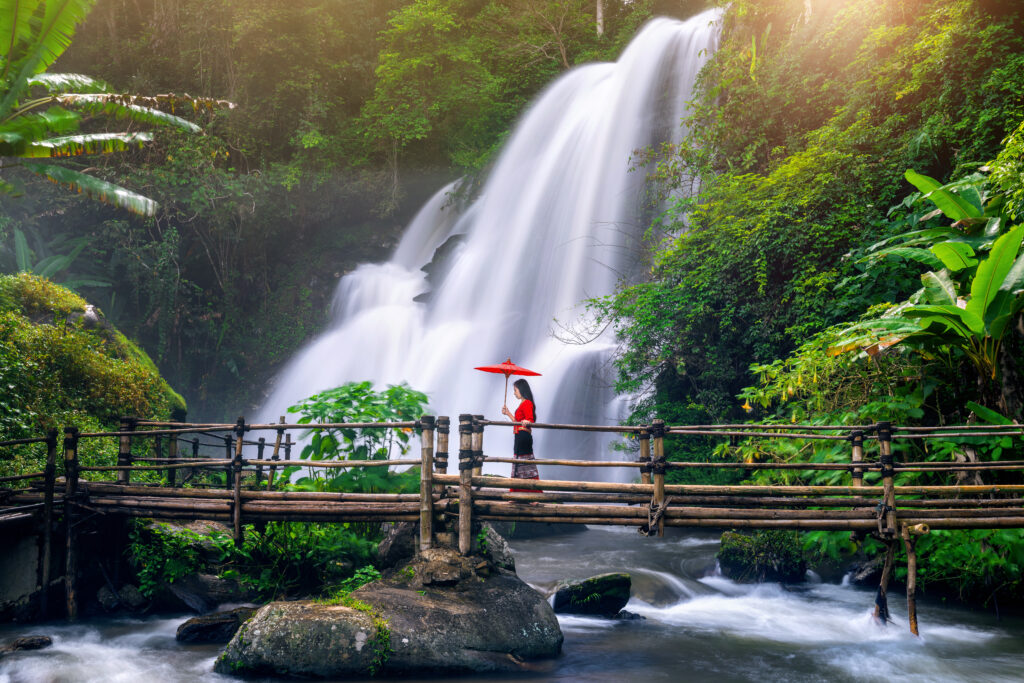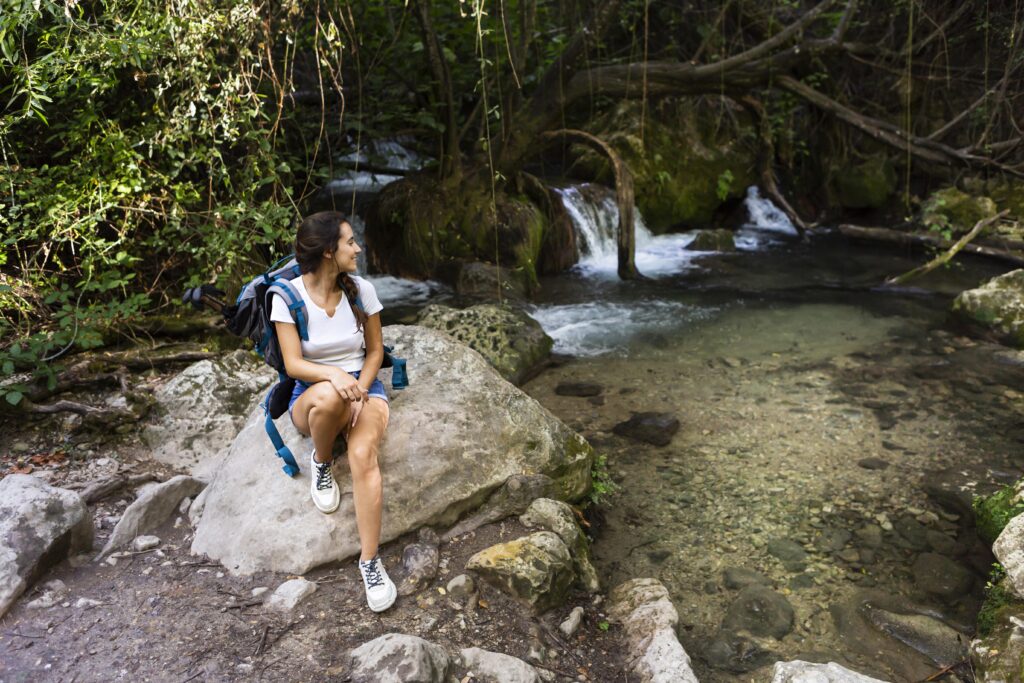When most people envision Cuba, images of aged cars, colorful colonial streets, and beach resorts immediately spring to mind. But beyond the popular tourist attractions lies a whole other side of the island—one with dense jungle, secret waterfalls, and a surprising amount of wildlife.
For those who love hiking, trekking through natural landscapes, and looking out for unusual birds or reptiles in their natural environment, Cuba is full of outdoor activities that are still quite untainted by mass tourism.
From Topes de Collantes’ cloud forests to the biodiversity hotspots within Alejandro de Humboldt National Park, the island is rich in diverse ecosystems. You will discover mountain paths, freshwater pools, limestone caves, and isolated swamps—all with something unique to offer for hikers and nature lovers.
The landscape can be rough, but the payoff is worth it: peaceful pathways, invigorating swims under waterfalls, and the possibility of spotting species that are nowhere else on our planet.
Here, we outline the Best Places to Travel in Cuba for hiking, waterfalls, and wildlife spotting.
Best Places to Travel in Cuba for Hiking, Waterfalls, and Wildlife Encounters

Cuba is commonly regarded as a beach resort or a cultural sightseeing destination. Although Havana, Varadero, and Trinidad are famous for their beauty, Cuba possesses a lesser-known natural dimension as well. The island boasts a remarkable diversity of ecosystems, including mountain ranges, rainforests, wetlands, and limestone valleys.
These ecosystems are biologically rich and offer great hiking, swimming alongside waterfalls, and wildlife watching opportunities. With over 200 protected sites and 25% of its territory under protection, Cuba is a fulfilling holiday destination for nature and outdoors enthusiasts. In this guide, we will be discussing the best destinations to visit in Cuba for trekking, waterfalls, and wildlife sightings.
Topes de Collantes – Escambray Mountains
Topes de Collantes is a nature reserve in the Escambray Mountains of central Cuba, close to the town of Trinidad. It is more than 200 square kilometers in size and consists of forests, rivers, waterfalls, and trails of varying difficulty. The high altitude and humidity here provide a rich environment, which makes the nature reserve a great location for hiking and wildlife sightings.
The most visited trail here is the Salto del Caburní hike. It is approximately 5 kilometers round-trip and winds through dense forest to a 64-meter-high waterfall. The hike is moderately challenging with steep and rocky areas. One can swim in the pool at the base of the waterfall. A second suggested trail is Vegas Grandes, which is steeper and more rugged but leads to a second pretty waterfall. La Batata is a shorter hike leading to caves and tiny pools.
Local wildlife here comprises various bird species like the Cuban trogon (the national bird), Cuban tody, and hummingbirds. Frogs, lizards, and local plant varieties are also found. It is best to accompany a local guide, particularly on the more isolated trails. The ground can be slippery after rainfall, and good footwear is vital.
Alejandro de Humboldt National Park – Eastern Cuba
Alejandro de Humboldt National Park is situated in eastern Cuba, extending over the Holguín and Guantánamo provinces. The park is one of the Caribbean’s most significant ecological locations and a World Heritage Site as declared by UNESCO. Spanning more than 700 square kilometers, the park features both mountain and coastal habitats that have high biodiversity levels and numerous endemic species.
Hiking here involves the services of local guides, and routes begin close to the town of Baracoa. Among the shorter, easier trails is El Copal, at 3.5 kilometers, which winds through forested areas with tall trees and orchids. Another trail is the 12-kilometer Balcón de Iberia, a hike that ends at El Majá waterfall. One of the tallest waterfalls in the area, this can be accessed after a moderately difficult hike. The El Recreo trail is shorter and emphasizes vegetation variety.
The park contains hundreds of rare plant species that don’t occur anywhere else. Wildlife comprises rainbow-colored land snails, butterflies, Cuban parakeets, and frogs. The diversity of ecosystems, from rainforest to mangrove, makes it a solid destination for hiking and nature watching. Access is strictly limited because of the protected status of the park, and prior booking with authorized guides is required.
Sierra Maestra – Granma Province
Sierra Maestra is a mountain range in southeast Cuba and is famous both for its natural scenery and historical significance. This region comprises Cuba’s highest point, Pico Turquino, at 1,974 meters. It is a rugged and remote region perfect for experienced trekking enthusiasts and mountain landscape seekers.
The toughest hike in Sierra Maestra is the Pico Turquino hike. It typically takes two or three days and involves camping overnight. The mountain is steep and needs excellent physical condition. The trek goes through various vegetation as the altitude rises, from tropical forest to cloud forest at higher altitudes.
For tourists who prefer a less longer and less strenuous route, the Comandancia de la Plata is also recommended. This route brings visitors to Fidel Castro’s old guerrilla headquarters buried in the mountains. While less physically challenging, it still provides a good glimpse of the Sierra Maestra landscape and vegetation.
Fauna in the area features woodpeckers, Cuban todies, lizards, and the Cuban boa. Because of the size and distance of the park from most locations, it is advisable to use a local guide for longer trails. The region is less developed from a tourism base, and so visitors must be suitably prepared with supplies, correct equipment, and prior reservations for accommodations.
Viñales Valley – Pinar del Río Province
Viñales lies in western Cuba and is most famous for its tobacco plantations and limestone mogotes. These unusual rock formations give way to a strange landscape of valleys, caverns, and rivers. Although the region is a UNESCO World Heritage Site primarily due to its cultural significance, it has a number of outdoor pursuits including hiking, horse riding, and wildlife watching.
There are a number of trails within the valley, and many are available on foot or horseback. Palmarito Valley trail travels through countryside farms and across rivers, to small waterfalls and natural pools where you can swim. You also have the El Resbaloso trail that leads to a secluded waterfall in the forest. The trail is moderate in difficulty and could need to be navigated with a guide.
Wildlife in the region features birds including Cuban trogon and red-legged thrush, as well as frogs and reptiles in the shade. The caves in the region, such as Cueva del Indio, are also noteworthy for their underground river and bat populations.
Viñales is highly suitable for eco-tourism, and there are numerous locals who provide guiding services. Nature explanations, history, and farming demonstrations are usually part of these tours. It’s an ideal choice for travelers seeking nature activities that don’t go too far off the grid.
Ciénaga de Zapata National Park – Matanzas Province
Ciénaga de Zapata, or Zapata Swamp, is Cuba’s largest wetland and most significant Caribbean ecological reserve. It occupies more than 4,000 square kilometers and contains a combination of marshes, mangroves, forests, and shoreline. Bird watchers, reptile watchers, and enthusiasts of swamp ecology have it just right here.
One of the principal birdwatching trails is the Bermejas Trail. It is a short and simple walk but provides viewing of numerous bird species, including the bee hummingbird, the world’s smallest bird, and the Cuban pygmy owl. Enigma de las Rocas is another busy trail, which goes through dry forest and alongside some of the limestone sinkholes. The trail has unusual rock formations and odd plants.
The Cuban crocodile, which only occurs in this part of the country, can also be found in the park. While one must be lucky and have a knowledgeable guide to spot them in the wild, some of the eco-tours involve a visit to the controlled habitats. Manatees, tree frogs, and more than 170 birds also inhabit the area.
Playa Larga town is a regular base for going to the park. Several eco-guides base themselves here and provide half-day or day tours. Weather can be hot and sticky, so travelers should arrive ready with water, insect repellent, and sun protection.
El Nicho – Cienfuegos Province
El Nicho lies between the towns of Trinidad and Cienfuegos and belongs to the greater Topes de Collantes natural park. It has well-trodden trails, clean rivers, and waterfalls. El Nicho is one of the more civilized natural sites to visit in Cuba and is appropriate for leisure hikers or families.
The principal walking path is the Sendero Reino de las Aguas that measures approximately 1.5 kilometers. It features footbridges, viewpoints, and entrances to numerous natural pools. The trail is in good condition, and the site has simple amenities like toilets and food stands. The waterfall here is approximately 30 meters in height and flows into a pool that has been opened for swimming.
While the region is more visitor-friendly than some of the others on this list, it does provide wildlife spotting in the form of hummingbirds, reptiles, and freshwater fish. The thick cover allows shade to be found and pleasant strolling even during the hotter months.
El Nicho can be part of day tours from surrounding cities, but it’s advisable to arrive early when visiting to escape the crowds. There is a parking and entrance fee, and there are local guides for those desiring further information on the local ecosystem.
Practical Travel Tips for Nature Exploration in Cuba
For nature travel and hiking in Cuba, the ideal time to go is in the dry season, between November and April. It is during this season that trails are easier to navigate and wildlife is still active. The rainy season between May and October makes trails slippery or even impassable, but waterfall flows are better during this season.
Visitors are advised to wear the correct footwear that is grippy, long-sleeved clothing that can protect against sun and insects, and refillable water containers. Most natural sites have poor facilities, so it’s a good idea to carry some basic equipment such as snacks, a first-aid kit, and tools for navigating. Mobile signal is poor in rural areas and GPS apps need to be pre-downloaded.
Local guides are frequently necessary for visitation in national parks and are highly advisable even when not necessary. Guides provide value by explaining wildlife and assisting with direction. Fees tend to be modest, and many have offices in small towns close to each park or reserve.
Gran Piedra – Santiago de Cuba
Gran Piedra, or “Great Stone,” sits in the Sierra Maestra mountains, 25 kilometers east of Santiago de Cuba. This massive volcanic boulder rises more than 1,200 meters above sea level and provides sweeping views of the southeastern coast. The location is part of the Baconao Biosphere Reserve, which features forested lands, botanical gardens, and ecological paths.
Hiking up the top of Gran Piedra entails more than 400 stone steps carved into the hillside. The route is brief but steep, and the climb will take 20 to 30 minutes depending on one’s pace. A large expanse of forest is visible from the top, as well as the coastline, in good weather. The temperature is visibly cooler because of the altitude, so the hike is comfortable even in hot months.
The forest surrounding it is densely vegetated with orchids, ferns, and fruit trees. The habitat of birds such as the Cuban trogon and the Cuban solitaire can be found in abundance in the region. At the foot of Gran Piedra, tourists can also venture into the Jardín Ave del Paraíso, a botanical garden featuring walking trails through tropical plant life.
The park can be reached by road from Santiago de Cuba, and guides are on hand at the gate. It’s a worthwhile half-day excursion for those seeking to combine a brief walk with scenery and vegetation.

Parque Natural La Mensura – Holguín Province
Parque Natural La Mensura is a lesser-traveled but worthwhile nature reserve in Holguín Province, close to the town of Mayarí. The park has pine woods, rivers, and several of the most stunning waterfalls in eastern Cuba. Its isolation results in fewer visitors and a quieter trekking experience.
The crown jewel of the park is Salto del Guayabo, one of Cuba’s tallest waterfalls, which drops approximately 100 meters. The falls are reached by a short hike that begins at a lookout point close to the entrance of the park. The descent to the bottom of the falls is steep but doable, and the space at the bottom is perfect for photography and lounging.
Other park trails go through pine forest and terminate at riverbanks, minor waterfalls, and natural pools. Pine along with tropical flora gives the atmosphere a distinct uniqueness. There are animals present, but they are shy; visitors can, however, see woodpeckers, lizards, and other insects.
There are basic facilities at the entrance, and guides for local walks can be employed for longer walks. Private transportation or an organized eco-tour is advisable to visit because it is not easily accessible. It’s perfect for those who desire a less crowded, more authentic hiking experience.
Conclusion
Cuba may be best known for its music, beaches, and colonial charm, but its natural landscapes offer just as much value for travelers who enjoy hiking, waterfalls, and wildlife encounters. From the misty trails of Topes de Collantes to the remote ecosystems of Alejandro de Humboldt National Park, the country provides a wide range of outdoor experiences that remain largely untouched by mass tourism.
Whatever your adventure be, whether mountain peaks of Sierra Maestra, cave exploration in Viñales, or bird watching in the Zapata Swamp, each destination provides a distinct combination of landscape, diversity, and indigenous culture.
What makes Cuba particularly attractive for nature travel is the diversity condensed into a small space. You can trek cloud forest in the morning and swim beneath a waterfall by lunchtime. With numerous national parks conserved and maintained by local guides, the experience is not only engaging but also sustainable.
For the traveler who wants more than a beach seat and a rum cocktail, Cuba provides a genuine and satisfying relationship with nature.
Through visiting these natural areas, you’re not only Best Places to Travel in Cuba—you’re getting to experience a part of Cuba that few of us bother to look at.





